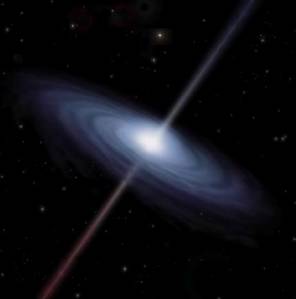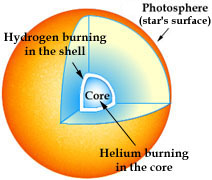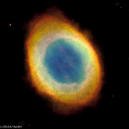A)
Characteristics
A black hole is a region of spacetime from which nothing can escape, even light.
It has so much mass concentrated in it that there is no way for a nearby object
to escape its gravitational pull. This celestial body (the black hole) may
contain the mass of a huge star compressed into a volume of only a few cubic
kilometers. The gravitational contraction of its nucleus is so powerful that
nothing can stop it. In other words if we compressed the Earth into a small
marble with a diameter of two centimeters, while keeping the same mass, this
marble could be a black hole, because it would have a small diameter, but a huge
mass with a high “escape velocity”,
higher than the velocity of light.
The “escape velocity” is the velocity that we need to escape from the gravitational field. For example the Earth’s escape velocity is 11.2 kilometers per second, while the Moon’s is only 2.4 kilometers per second, but an object (a black hole) with such an enormous concentration of mass in such a small radius has its escape velocity equal or even greater than the velocity of light.

A black hole, which was
observed with X-rays
The black hole is a celestial body, which has some specific characteristics.
Indeed we can observe four main characteristics, which are the Event Horizon,
Singularity, the Schwarzschild Radius and escape velocity.
First a black hole can be defined by its Event Horizon, which is the area
surrounding a black hole where escape velocity is equal to the speed of light.
Event
Horizon : C = (3.0exp^10)
Then we can speak about Singularity, which is the center of a black hole, a
place where space time is twisted and where
the entire density of the black hole is concentrated.
The distance from Singularity to the Event Horizon is the Schwarzschild Radius.
The Schwarzschild Radius is the distance from the center of a black hole to its
Event Horizon. Before Russian physicist Karl Schwarzschild calculated this
distance, the boundaries of black holes were a mystery. His work was completed
by Einstein's theory of general relativity, which induced the ability to
calculate gravity at high speeds and large masses. The equation for calculating
the Schwarzschild radius is:

In
this formula m is the mass of the
black hole, G is the universal
gravitational constant, and c is the
speed of light. The "radius" is essentially the distance from the center of the black hole, singularity, to the edge of the black hole, the event
horizon.
This
chart shows different objects that we can find in the Universe, and it compares
their characteristics. It is rather interesting, because it allows us to see how
huge objects exist in the Universe.
|
astronomical
object |
mass
(kg) |
radius
(km) |
escape
velocity (km/sec) |
|
Earth |
6x1024 |
6,400 |
11 |
|
Sun |
2x1030 |
700,000 |
610 |
|
neutron
star |
4x1030 |
10 |
230,000 |
|
black
hole |
8x1030 |
1 |
1,000,000 > c = 300,000 |
B)
Formation of black holes.
Black
holes can be formed in many different ways. Still, nowadays scientists have two
main hypotheses.
Actually
there are two different kinds of black holes :
-Stellar
black holes, formed from giant stars.
-Galactic
black holes, formed in the center of each galaxy (also called supermassive black
holes).
1°)
Stellar black holes
Most black holes are said to be stellar: formed from stars. Scientists estimate that our galaxy contains 10 million of these black holes.
Their
mass can be 10 times that of the sun and their event horizon (spatial limit from
which no object can escape the gravitational force) can be a few kilometers
long.
Stars are not eternal. A star is composed of 70% hydrogen, 28% helium and 2% heavy elements (carbon and others). During its life, a star burns hydrogen to produce helium (4 hydrogen atoms give 1 helium atom) . This reaction gives them energy to resist against the gravitational force. When there is not enough hydrogen, the star starts dying. Each star whose mass is above four times that of the sun (the Oppenheimer-Volkoff mass limit) will eventually become a black hole. With a mass that can be as much as ten times that of the sun, becoming a stellar black hole is the normal way for a giant massive star to end its life.
The
formation of a stellar black hole follows many steps :

In
Red Giant stars, the core is composed of helium and heavy elements, with a thin
hydrogen-burning shell. A Red Giant is many times bigger than a normal star.
b)
And then, the Red Giant degenerates into a White Dwarf.
As
hydrogen burns on the surface of the Red Giant, helium (which is heavier)
concentrates in the core, and when the hydrogen has been totally burnt, all that
is left is helium and the original heavy elements. Then, helium turns into
carbon and oxygen (which are much heavier). These new heavy elements get
concentrated in the center of the star : a White Dwarf is formed

Here
is an image of the Hour
Glass Nebula, a Red Giant turning into a White Dwarf. In this view, we can see
the different colors which correspond to the different chemical elements. In
the center (blue – mainly helium)
we can see the core of the Red Giant, which will become the White Dwarf.
So
a White Dwarf has a small extremely dense core which is mainly composed of
carbon and oxygen formed from helium.

Here
is a picture of a White Dwarf
c) The last step before becoming a black hole, being a neutron star.
The
White Dwarf’s density increases with gravity : the heavy elements get more and
more compressed, so that the pressure becomes higher and higher in its core.
Finally the neutron star, because of its extremely high density, turns into a black hole.
2°)
Galactic black holes
Supermassive
black holes, whose mass can be one million to one billion time that of the Sun
confined in a region no larger than our Solar System, reside in the center of
galaxies. Some scientists speculate that most galaxies, including our own,
harbor a galactic black hole. The theory is that these large-mass black holes
are formed from collapsed gas when the host galaxies got formed.
The
supermassive black hole is the source of large amounts of energy. All of the gas
that pours into a black hole puts up quite a fight. The gas, under the force of
extreme gravity, heats to millions of degrees and releases bright light across
most of the electromagnetic spectrum, from radio waves through to optical light.